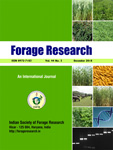SUNIL, VINOD KUMAR*, PUNESH SANGWAN, VISHAL CHUGH, SUSHIL NAGAR ANDNEERAJ KHAROR
Department of Biochemistry, College of Basic Sciences & Humanities, CCS Haryana Agricultural University,
Hisar-125 004 (Haryana), India
Division of Biochemistry, FBSc, SKUAST-Jammu, Main Campus Chatha-180 009 (J&K), India
Department of Basic and Social Sciences, College of Horticulture, Banda University of Agriculture and Technology,
Banda-210 001 (Uttar Pradesh), India
*(e-mail: sangwan.vinod@yahoo.com)
(Received: 15 March 2025; Accepted: 30 March 2025)
SUMMARY
Iron (Fe) is crucial for various biological functions, including plants. The deficiency of Fe is a vital problem in calcareous soils due to poor Fe3+ solubility, which limits plant growth and yield. In India, 13% of soils are affected by Fe deficiency. The present study was conducted under hydroponic conditions on contrasting Fe-containing Pearl millet hybrids to evaluate their performance under Fe deficiency and the effect of Sulphur (S) supplementation on its growth characteristics under such treatments. Significant changes in the shoot length, root length, leaf area, and chlorophyll content were observed in both genotypes. The shoot length, root length, leaf area, and chlorophyll were highest in treatment with Fe and S (+Fe+S), whereas the lowest values were obtained in the absence of Fe and S (-Fe-S) in both genotypes. Compared to both Fe and S absence, the application of S decreased chlorosis in the absence of Fe, which reveals mimicking of Fe deficiency symptoms by S application. Comparatively, leaf area was significantly higher in Fe-biofortified hybrid HHB-299 over non-biofortified hybrid HHB-67 (Improved). Overall, Fe-biofortified hybrid HHB-299 performed better over non-biofortified hybrid HHB-67 (Improved) under Fe deficient conditions and exhibited better tolerance to deficiency of Fe.
Key words: Hydroponic, Fe deficiency, sulphur application, pearl millet, biofortification

